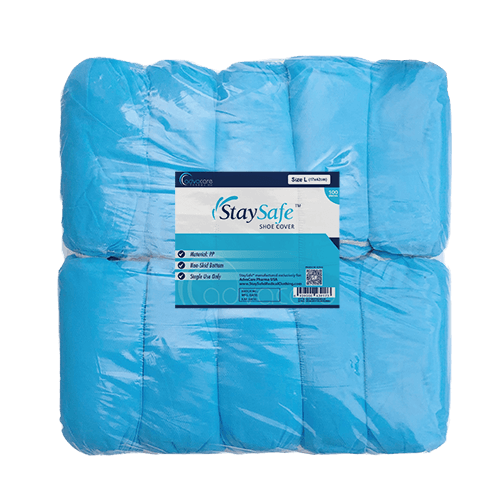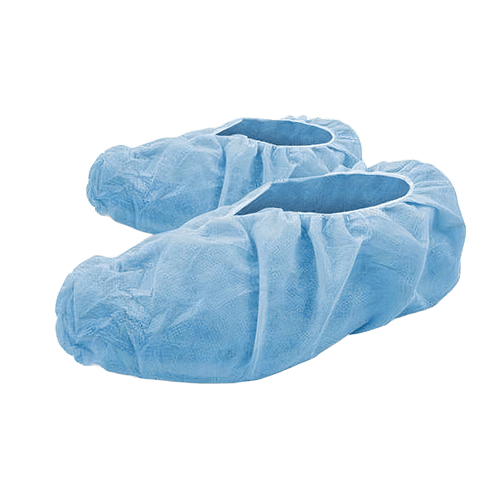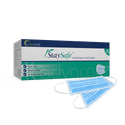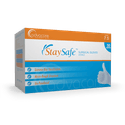Shoe Covers
Type
Material
Size
Packaging
What are Shoe Covers?
Shoe Covers are single-use protective coverings worn to protect the shoes and to prevent contamination of floors and the environment. This type of personal protective equipment (PPE) is commonly used in healthcare settings, laboratories, food processing, and other settings in which maintaining sterility is important.
Disposable shoe covers are made from PE (polyethylene), PP (polypropylene), or SMS (spunbond-meltblown-spunbond), and are available in a range of sizes, from small to large, as proper sizing ensures a secure fit and maximizes coverage of the footwear.
Shoe Covers are manufactured by AdvaCare Pharma, an American-owned pharmaceutical company with extensive experience in worldwide distribution. These shoe covers are produced in CE/ISO-certified facilities, where regular inspections guarantee that our facilities and our products meet stringent health, safety, and environmental standards.
Product Specifications
Type
Material
Standard Shoe Covers
Standard shoe covers are the most commonly used type of shoe cover. They are designed to cover only the shoe itself and are typically manufactured from materials such as polypropylene, polyethylene, and chlorinated polyethylene.
Standard shoe covers are intended to protect the shoe but do not extend further up the leg like a boot cover.

Non-Skid Shoe Covers
Non-Skid Shoe Covers are equipped with a ribbed or textured surface on the underside that is intended to enhance traction and grip on the floor. This feature helps ensure a safer environment for both the medical team and patients by reducing the risk of slipping and falling.
Non-skid shoe covers are typically made from polypropylene material, which provides an additional layer of protection against contaminants.
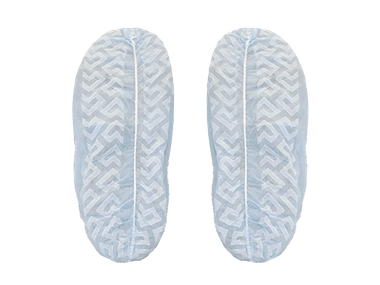
Medical Boot Covers
Medical Boot Covers extend further up the leg than a standard shoe cover. They reach up to the shin area, which offers more protection for the wearer, as it protects a larger area of the body.
Medical boot covers are typically made from polypropylene or chlorinated polyethylene, which offer durability and resistance to liquids.
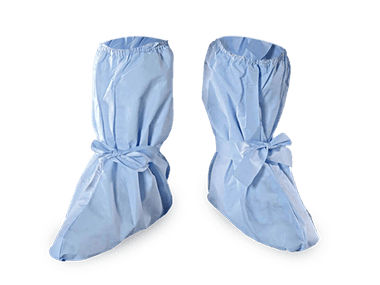
Polyethylene (PE)
Polyethylene (PE) shoe covers are manufactured from polyethylene, which is a lightweight, disposable plastic material. This material is typically water-resistant and provides a basic barrier against dirt, dust, and some liquid splashes. Shoe covers made from PE are economical and suitable for general use in low-risk environments.
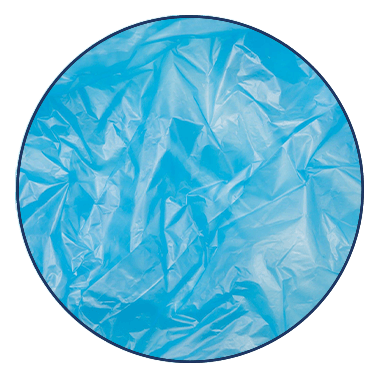
Polypropylene (PP)
Polypropylene (PP) shoe covers are composed of the polymer polypropylene, which is a durable and lightweight material. This material is waterproof and able to protect the wearer from liquids and fluids. Additionally, PP provides chemical resistance, ensuring an added layer of protection against potentially harmful substances and contamination. It is suitable for settings where protection from fluids and chemicals is crucial.
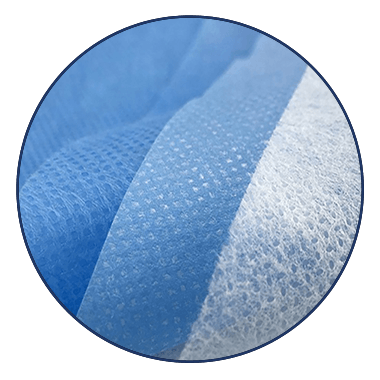
Spunbond-Meltblown-Spunbond (SMS)
Spunbond-Meltblown-Spunbond (SMS) shoe covers are produced from a three-layered material that consists of spunbond, meltblown, and spunbond. This unique combination of materials offers excellent strength and durability. The meltblown layer serves as a protective barrier against bacteria, which enhances the gown's ability to prevent the transmission of infectious agents.
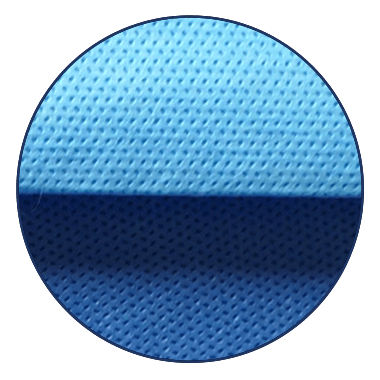
Why are we a top Shoe Covers manufacturer?
AdvaCare Pharma is a leading global manufacturer of Shoe Covers and other PPE medical disposables. Each of our products is accompanied by a comprehensive STED dossier, instilling confidence in our partners and distributors that our medical supplies consistently meet the highest standards of quality.
Drawing upon over two decades of industry experience, we have developed a distribution network that extends to 65 markets across the globe. Our business model is focused on creating a strong partnership with our distributors, and our professional team offers unbeatable assistance throughout the entire process - from supply chain coordination to registration support.
Uses
What are Shoe Covers used for?
Shoe Covers are used for maintaining cleanliness and preventing contamination across different settings. Their primary function is to offer a protective barrier over footwear, preventing the transfer of dirt, dust, or potentially harmful substances from shoes to the surroundings. This function is particularly valuable in environments where upholding high levels of hygiene and cleanliness is mandatory.
How are Shoe Covers worn?
To maximize the efficacy of Shoe Covers, they must be worn properly. This involves selecting the right size for a snug fit, inspecting them for any defects before use, carefully sliding them over the shoes, and making any necessary adjustments for secure coverage.
Complying with these steps, individuals can be assured that the Shoe Covers will create a barrier against contaminants and upholding cleanliness standards.
Are there any storage recommendations for Shoe Covers?
Preserving the cleanliness and integrity of Shoe Covers before use requires proper storage. Unused Shoe Covers should be kept in a clean, dry area, shielded from direct sunlight, sources of heat, and moisture.
Retaining them in their original packaging is beneficial for protection against external conditions. Placing Shoe Covers in a readily accessible spot is also good practice so they can be quickly utilized when necessary.
How should used Shoe Covers be disposed of?
Discarding used Shoe Covers correctly is basic for preventing contamination spread and upholding a clean setting. To remove used Shoe Covers, it is necessary to do so with caution to avoid touching the contaminated parts.
They should be deposited into a waste container allocated for non-hazardous materials. Following the disposal, engage in thorough hand washing or sanitizing to reduce contamination risks.
How are Shoe Covers used in hospitals?
Shoe Covers aid in upholding the stringent hygiene and infection control standards within hospital settings. These facilities cater to patients undergoing surgeries, treatments, and recovery for a range of medical conditions.
Shoe Covers are indispensable in cleanliness, especially in operating rooms and intensive care units, for a contaminant-free space for patient care and recovery.
This is how Shoe Covers are used in hospitals:
- Sterility: Hospitals house areas like operating rooms and intensive care units where sterility is of utmost importance. Before entering these zones, healthcare professionals, such as doctors and nurses, are required to don Shoe Covers.
- Preventing Contaminant Spread: The healthcare staff often move between different areas of the hospital, including patient wards, laboratories, and surgical suites. During these transitions, they can inadvertently carry contaminants from one location to another via their shoes. Wearing Shoe Covers minimizes this risk, as any dirt, dust, or microorganisms that might have stuck to their shoes are contained within the covers.
- Hygiene: Hospitals prioritize hygiene to reduce the risk of healthcare-associated infections. Shoe Covers contribute to this effort by reducing the introduction of foreign particles and microorganisms into sterile environments. This proactive measure aligns with best practices in infection control and helps safeguard both patients and medical personnel.
- Compliance with Protocols: Hospitals typically have strict protocols and guidelines for infection prevention. The use of Shoe Covers is often mandated as part of these protocols. Healthcare professionals are trained to adhere to these guidelines diligently, guaranteeing consistent use of Shoe Covers when entering designated sterile areas.
- Patient Safety: The primary goal of using Shoe Covers in hospitals is to elevate patient safety. Patients undergoing surgery or those with compromised immune systems are particularly vulnerable to infections.
Shoe covers are a simple tool that healthcare professionals use to create a barrier between their shoes and the sterile environments where patient care is provided. This practice is all-important in upholding the highest standards of hygiene, safeguarding patient well-being, and minimizing the risk of hospital-acquired infections.
FAQs
What type of Shoe Cover should be used?
The choice between the three styles is dependent on factors like the level of protection required, the working environment, and personal preference. Standard shoe covers are ideal for healthcare settings and other industries where basic protection is needed.
Non-skid shoe covers are particularly useful in environments where floors may be wet or slippery, such as hospitals, labs, and food service areas. Medical boot covers provide a higher level of coverage, and they are commonly used in surgical settings and other sterile environments.
What are the advantages of the different materials for Shoe Covers?
PE shoe covers are lightweight, inexpensive, and provide a basic level of protection against dirt and mild liquids. They are ideal for environments where minimal protection is required, such as non-sterile areas or low-risk settings. PP shoe covers are more durable and resistant to tearing compared to PE shoe covers, which makes them ideal for healthcare settings, laboratories, and cleanrooms where a higher level of protection is necessary. SMS shoe covers are highly durable and offer excellent protection in healthcare settings and other environments where a high level of cleanliness is required.
Can Shoe Covers be used outdoors?
Shoe Covers offer a basic level of protection against dirt and light splashes and are primarily intended for indoor use. Extended outdoor use or exposure to harsh conditions may compromise the integrity of the material.
Can I request samples of your Shoe Covers for evaluation?
We do provide samples of our medical devices to aid in evaluation and product registration. Contact our International Sales Department to request samples tailored to your specific requirements.
Can I distribute Class I medical devices in my country after importing them?
Class I medical devices generally undergo simpler registration processes, enabling their importation and distribution in foreign countries with relative ease. However, a medical distributor must ensure of proper licensing and local compliance for the importation and/or distribution of medical devices.
References
Evidence for the Inclusion of Shoe Covers in PPE for COVID-19
The guidance recommends the use of shoe covers when there is a risk of splashing from infected body fluids. However, official UK guidance updated in April 2020 does not make any recommendations for the use of shoe covers. The article emphasizes the need to assess the contagion risk and use recommended PPE, including shoe covers, in specific situations. It also discusses the technical specifications for these items based on past outbreaks of similar viruses.
Indications for Accurate and Appropriate Use of Personal Protective Equipment for Healthcare Professionals: A Systematic Review
The systematic review discusses the use of personal protective equipment (PPE) for healthcare professionals, including the importance of shoe covers in preventing the transmission of infectious agents. It emphasizes the need for accurate and appropriate use of PPE, such as shoe covers, to ensure the safety of healthcare workers and patients.

You might be interested in...
Why AdvaCare Pharma?
As an industry leader, we are aware of our responsibility to provide affordable and sustainable solutions to improve healthcare worldwide.
